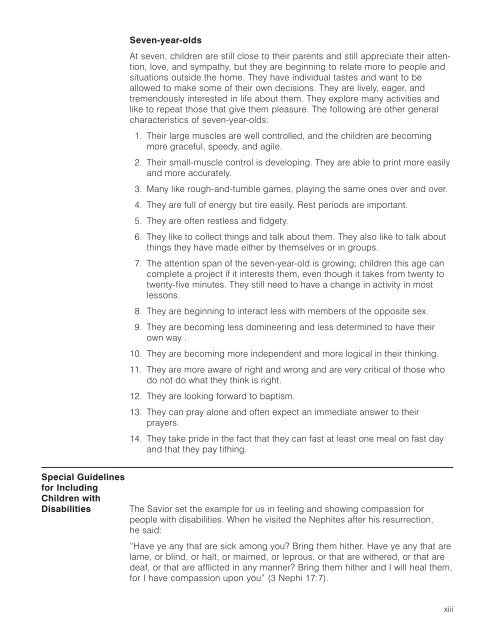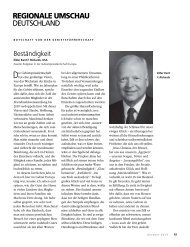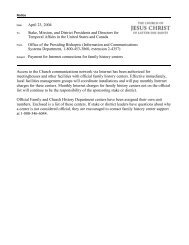Primary 3 Manual - The Church of Jesus Christ of Latter-day Saints
Primary 3 Manual - The Church of Jesus Christ of Latter-day Saints
Primary 3 Manual - The Church of Jesus Christ of Latter-day Saints
You also want an ePaper? Increase the reach of your titles
YUMPU automatically turns print PDFs into web optimized ePapers that Google loves.
Seven-year-olds<br />
At seven, children are still close to their parents and still appreciate their attention,<br />
love, and sympathy, but they are beginning to relate more to people and<br />
situations outside the home. <strong>The</strong>y have individual tastes and want to be<br />
allowed to make some <strong>of</strong> their own decisions. <strong>The</strong>y are lively, eager, and<br />
tremendously interested in life about them. <strong>The</strong>y explore many activities and<br />
like to repeat those that give them pleasure. <strong>The</strong> following are other general<br />
characteristics <strong>of</strong> seven-year-olds:<br />
1. <strong>The</strong>ir large muscles are well controlled, and the children are becoming<br />
more graceful, speedy, and agile.<br />
2. <strong>The</strong>ir small-muscle control is developing. <strong>The</strong>y are able to print more easily<br />
and more accurately.<br />
3. Many like rough-and-tumble games, playing the same ones over and over.<br />
4. <strong>The</strong>y are full <strong>of</strong> energy but tire easily. Rest periods are important.<br />
5. <strong>The</strong>y are <strong>of</strong>ten restless and fidgety.<br />
6. <strong>The</strong>y like to collect things and talk about them. <strong>The</strong>y also like to talk about<br />
things they have made either by themselves or in groups.<br />
7. <strong>The</strong> attention span <strong>of</strong> the seven-year-old is growing; children this age can<br />
complete a project if it interests them, even though it takes from twenty to<br />
twenty-five minutes. <strong>The</strong>y still need to have a change in activity in most<br />
lessons.<br />
8. <strong>The</strong>y are beginning to interact less with members <strong>of</strong> the opposite sex.<br />
9. <strong>The</strong>y are becoming less domineering and less determined to have their<br />
own way .<br />
10. <strong>The</strong>y are becoming more independent and more logical in their thinking.<br />
11. <strong>The</strong>y are more aware <strong>of</strong> right and wrong and are very critical <strong>of</strong> those who<br />
do not do what they think is right.<br />
12. <strong>The</strong>y are looking forward to baptism.<br />
13. <strong>The</strong>y can pray alone and <strong>of</strong>ten expect an immediate answer to their<br />
prayers.<br />
14. <strong>The</strong>y take pride in the fact that they can fast at least one meal on fast <strong>day</strong><br />
and that they pay tithing.<br />
Special Guidelines<br />
for Including<br />
Children with<br />
Disabilities <strong>The</strong> Savior set the example for us in feeling and showing compassion for<br />
people with disabilities. When he visited the Nephites after his resurrection,<br />
he said:<br />
”Have ye any that are sick among you? Bring them hither. Have ye any that are<br />
lame, or blind, or halt, or maimed, or leprous, or that are withered, or that are<br />
deaf, or that are afflicted in any manner? Bring them hither and I will heal them,<br />
for I have compassion upon you” (3 Nephi 17:7).<br />
xiii

















